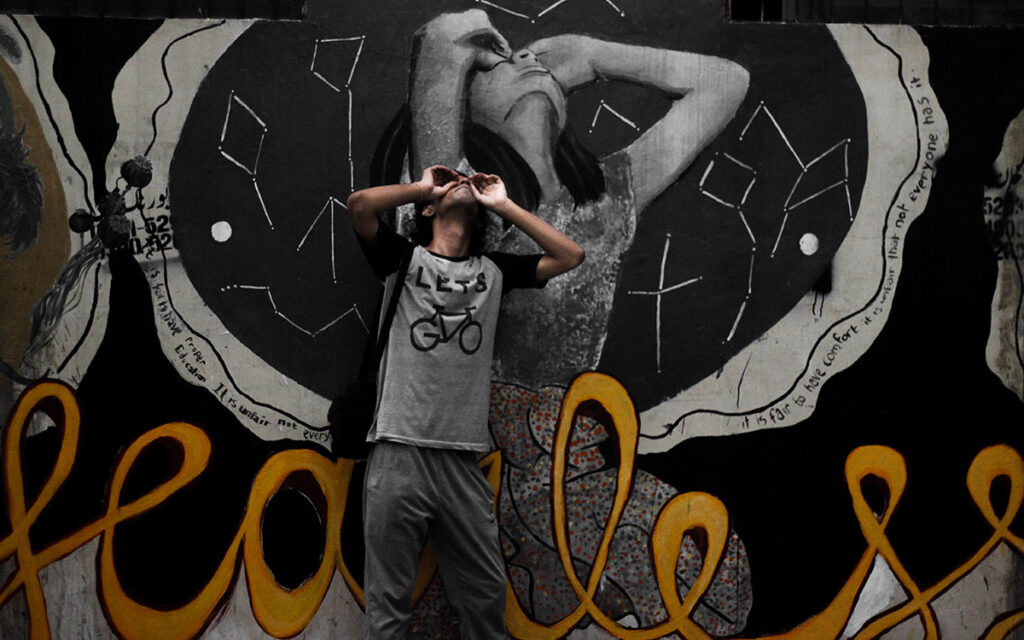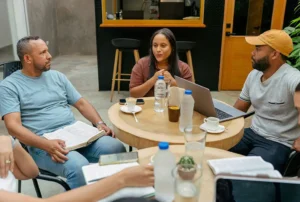
To solve our most pressing challenges, we need the total sum of human intelligence and emancipatory energy in our society. This includes the expertise and leadership of people with disabilities. Alice Wong, founder and director of the Disability Visibility Project, wrote, “There is so much that able-bodied people could learn from the wisdom that often comes with disability. But space needs to be made. Hands need to reach out. People need to be lifted up.”
People with disabilities are leading policy change, technology development, and workplace evolution. In addition to ensuring the successful passage of the Americans with Disabilities Act, they are impacting internet accessibility standards and offering community-centered approaches to surviving crises like the pandemic and climate change. Yet institutions and funders continue to underinvest in their leadership and expertise.
As funders at the Ford Foundation and Borealis Philanthropy, we seek to leverage our positions to advocate for greater support and funding for disabled leaders. The newly launched Disability x Tech Fund, which focuses on technology justice, offers a framework for how we can collectively resource these leaders.
To solve our most pressing challenges, we need the total sum of human intelligence and emancipatory energy in our society. This includes the expertise and leadership of people with disabilities.
Integrating Disability Justice into Technology
The intersection of technology and disability justice has been historically underresourced. However, it presents enormous opportunities to disrupt inequality. This is because when we talk about technology justice, we are not simply talking about tools in isolation. Our interactions with technology are shaped and intermediated by the people who design them, the decisions made on how to deploy them, and the human-created rules that govern them.
Technology justice requires understanding who is included or excluded from these processes. People of color, immigrants, women, LGBTQIA people, and people with disabilities all experience social inequities that extend to technology and are less likely to be in the room when technology is developed. In fact, processes for designing and developing technology are highly exclusionary, often lacking the vital perspectives and lived experiences needed to ensure it works for everyone.
Inclusion and equity across every level of tech design, deployment, and governance is crucial. A long-held mantra of the disability justice community is “Nothing about us without us.” As Wong alludes to, if we center the leadership and expertise of people with disabilities, we will not only tap into technological innovation and creativity but also imagine a more equitable future for all.
A world where true technology and disability justice are realized calls for a new paradigm within which:
- The expertise and experiences of people with disabilities are prioritized across all stages of technology development, deployment, and governance.
- There is ample funding, support, respect, and validation for disabled leaders and disability-led organizations working to ensure technology serves everyone.
- The institutions and systems that develop, deploy and govern technologies are focused on eliminating harms that exclude, marginalize, and oppress people—including ableist biases, algorithmic discrimination, and other forms of disparate treatment toward people who face intersecting forms of systemic marginalization.
The intersection of technology and disability justice, while historically underresourced, provides enormous potential to disrupt inequality in myriad forms.
Technology Falling Short
This new paradigm can only be realized if the disability justice lens we bring to technology is intersectional. Consider, for example, approaches to ensuring voting access. Equal access to the ballot box is not only a fundamental part of our democracy, it is also required by law. Yet, people with disabilities continue to face disproportionate barriers that make it challenging or essentially impossible to exercise their fundamental right to vote.
There are many technological solutions for improving voting accessibility. Text-reading software, digital magnifiers, and audio-tactile keypads—essential accommodations for ensuring voters who are blind, visually impaired, deaf, hard of hearing, or deafblind can privately cast their ballot at the polls—are necessary and can be beneficial for everyone. But these solutions often lack an intersectional equity analysis. For example, many of these technological innovations, like screen readers, don’t account for gaps in access to smartphones, computers, or other electronic devices—gaps that particularly affect low-income voters and voters of color.
Another example of technological harm can be seen in the case of surveillance. While studies have shown repeatedly that surveillance technologies are inherently biased and discriminatory, those technologies are being deployed in increasingly prominent and inescapable ways in our daily lives, from classrooms to workplaces. Even as students and workers are asked to consent to being surveilled, opting out can mean a failing grade or job loss.
For example, remote proctoring tools may inadvertently single out students who experience involuntary spasms, rapid eye movement, motor tics, and other naturally occurring characteristics of some disabilities, flagging them as cheating and punishing them simply for having a disability.
In the workplace, these technologies are used to standardize an inherently ableist image of productivity and efficiency, incentivizing or penalizing workers based on speed and, at times, firing the slowest workers, regardless of the individual’s disability or access needs.
Sign up for our free newsletters
Subscribe to NPQ's newsletters to have our top stories delivered directly to your inbox.
By signing up, you agree to our privacy policy and terms of use, and to receive messages from NPQ and our partners.
As state governments increasingly rely on machine learning and technology to determine whether people qualify for public benefits and to what extent they receive them, many people with disabilities are losing critical support without warning or explanation.
When technology is deployed or governed irresponsibly, it exacerbates inequities and further marginalizes disabled people—especially those who are multiply marginalized. Technology solutions created for people with disabilities—but without their input—can fail to effectively meet the disabled community’s diverse needs and interests or, in some cases, exclude them altogether.
Hope for the Future, Now
There is diligent, community-led, transformational work happening every day across the country. We are seeing the impact of efforts to advance technology solutions that intentionally center on people with disabilities.
For example, with respect to voting solutions, several disabled leaders are advocating for low-cost, nontechnological solutions that can be implemented now. These include training poll workers on disabled voters’ rights, providing plain language formatting and American Sign Language translations for voting rights materials, and ensuring voting locations are near public transportation and set in ADA-compliant buildings. These solutions would make an enormous difference in ensuring voting is accessible for people with disabilities.
Regarding technological surveillance, the Surveillance Technology Oversight Project is working to broadly limit the use of surveillance technologies and ableist surveillance practices through litigation, legislation, education, and advocacy.
To address surveillance bias and algorithmic tracking, Community Legal Services has partnered with the Autistic People of Color Fund to further analyze the use of algorithmic decision-making systems, automated tools, and other artificial intelligence applications used in eligibility determinations. This includes assessment of the reliability of these tools and examining their potential to reduce medically necessary care or otherwise deny treatment to participants—especially disabled people of color.
Another example of progress is the Equal Employment Opportunity Commission and the Department of Justice’s first-ever agency guidance to prevent AI-based systems from discriminating against people with disabilities. The guidance was developed after significant input and advocacy from disability leaders. It was a substantial win in addressing hiring inequities in the digital world that has long been prevalent in the analog world.
But there is still work to be done. These efforts experience limited and siloed funding that fails to acknowledge the immense power and creativity of disabled leaders and disability-led organizations. A collective approach—especially among funders—is needed to invest in systems change that ultimately creates an equitable future.
Calling for a Collective Approach
Philanthropy can and must work more intentionally to dismantle the ways ableism persists as an obstacle to building relationships and moving resources to disability-led organizations. We know we are not alone in believing that there can be no justice without disability justice and that technology—including all its benefits and consequences—is intrinsically connected to our fight.
That said, for many who are taking the first steps in their journey, it can be difficult to know where to start. A 2021 report developed by the American Association of People with Disabilities and the Center for Democracy and Technology is a great landscape resource offering multiple avenues for entry.
Further, the Disability x Tech Fund can serve as a guide star for funders who want to engage in this work. We launched this fund to support disability-led groups working to bring about transformational change at the intersections of disability rights, justice, and technology. The Disability x Tech Fund was designed by, for, and with disabled leaders and models a vision where the perspectives of people with disabilities are not only considered but prioritized in technology development.
Drawing from some of our biggest lessons learned, here are five key action steps to help funders engage in this space:
- Establish a representative advisory committee. This is crucial, especially for funders entering a new field. Funders must assess where they get the information needed to decide how to direct and prioritize funding. In establishing the Disability x Tech Fund, we knew it was important to follow the leadership of disabled people and disability-led organizations with the direct experience and expertise to identify gaps in funding and make strategic recommendations. As such, we prioritized the advisory committee at the earliest stages of the fund.In fact, the Disability x Tech Fund was born out of a year-long process led by an advisory committee made up of people with disabilities, which then informed our strategies for the fund’s mission and nominated and selected the inaugural cohort of awardees.
- Prioritize organizations that are disability-led and disability-serving. And when possible, prioritize disability-led organizations that are also led by people who are Black, Indigenous, People of Color (BIPOC), queer and gender nonconforming, and women.Our advisory committee followed these priorities in selecting partners for the inaugural Disability X Tech grantee cohort, understanding that those directly harmed by injustice and exclusion should be involved in strategies to advance justice and inclusion. Priority should also be given to organizations led by people subject to systemic bias and impacted by underrepresentation.
- Use the collective power of a cohort model. Disability justice leaders have long prioritized collectivism, and we sought to center that by investing in a cohort model. Funders should consider a cohort model rather than traditional avenues like calls for proposals, which create silos. When we initially set up the advisory committee, members explicitly expressed interest in engaging with one another. With their partnership, we developed capacity building and knowledge-sharing opportunities to facilitate an ongoing exchange of ideas, and we have witnessed the benefits firsthand. By regularly convening this cohort, grantees are building relationships and engaging in a cross-movement collaboration that elevates their individual efforts and expertise and strengthens the cohort’s collective priority of addressing ableism in technology.
- Emphasize intersectional work that engages other social movements and injustices. Disability justice is integral to every social justice movement strategy—including racial justice, climate justice, immigrant rights, economic justice, and labor rights.When funders already invested in social and transformative change do not move resources directly to disability justice work, none of our movements can achieve transformational change. Even when an organization or effort does not explicitly name disability, it does not mean that people with disabilities and their communities are not involved.For example, faced with compounding institutional and systemic barriers, people with disabilities experience heightened economic insecurity. Yet many of the solutions that exist to open economic participation for people with disabilities are intermediated by technologies that present further barriers to participation. These include cumbersome, time-consuming, or redundant enrollment processes to access essential services and requirements for online forms of payment that exclude disabled people who are unbanked or prefer cash and that fail to account for privacy concerns.Nonprofit Suma is partnering with frontline communities and people living in poverty—about 21 percent of disabled people are considered poor—to create an open-source, web-based app to enable people with disabilities to participate in the digital economy and access essential goods and services. The app is designed to reduce costs; simplify access to benefits, subsidies, and discounts; accept multiple forms of payment while protecting user privacy; and function even in areas of spotty cellular service.
- Be intentional about the type of funding given. Funders should make meaningful investments, including long-term or general operating support. Provide funding for paid fellowships and other long-term opportunities for people with disabilities and disability rights experts to contribute directly to technology policy work. Invest in building pipelines and partnerships that encourage disability inclusion in the technology sector and fund technology justice organizations to focus on true inclusion rather than just accessibility.
People with disabilities—and other communities experiencing systemic inequities—value and benefit from community and collectivism. As our world continues to become more technology-dominant, equitable access to digital tools and platforms is necessary to sustain the power of disability-led systems and efforts designed to support mutual needs and interests. And philanthropy can play a critical role in this collective by funding and supporting the efforts of leaders with disabilities.











